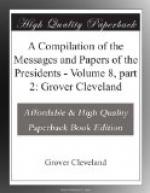BENJ. HARRISON.
EXECUTIVE MANSION, April 29, 1890.
To the House of Representatives:
I return without my approval the bill (H.R. 848) “to authorize the construction of an addition to the public building in Dallas, Tex.”
The bill authorizes the construction of a wing or addition to the present public building at a cost of $200,000. I find that the bill as originally introduced by the member representing the Congressional district in which Dallas is situated fixed $100,000 as the limit of the proposed expenditure, and it was so reported from the Committee on Public Buildings and Grounds after conferring with the Supervising Architect of the Treasury. A bill of the same tenor was introduced in the Senate by one of the Senators from that State, fixing the same limit of expenditure.
The public building at Dallas, for which a first appropriation of $75,000 was made in 1882, subsequently increased to $125,000, was only completed in 1889. It is probably inadequate now to the convenient transaction of business, chiefly in that part assigned to the Post-Office Department. The material and architectural style of any addition are fixed by the present building and its ground area by the available unoccupied space, as no provision is made for buying additional ground. The present building is 85 by 56 feet, and Mr. John S. Witwer, the postmaster and the custodian of the building, writing to the Supervising Architect, advises that to meet the present and prospective needs of the Government an addition at least two-thirds as large as the present building should be provided. It will be seen from the following extract from a letter of the Supervising Architect to the chairman of the Senate Committee on Public Buildings and Grounds, dated February 17, 1890, that a building larger than that suggested can be erected within the limit of $100,000. He says:
From computations made in this office based upon data received it is found that an extension or wing about 40 by 85 feet in dimensions, three stories high, with basement, giving 3,400 square feet, in addition to the 4,760 square feet of the first-floor area of the building, of fireproof construction, can be erected on the present site within the limit of cost proposed by said bill, namely, $100,000.
It may be possible that an expenditure of $325,000 for a public building at Dallas, if the questions of site, material, and architecture were all undetermined, could be defended, but under existing conditions I do not see how an appropriation of $200,000 can be justified when one-half that sum is plainly adequate to such relief as the present site allows.




